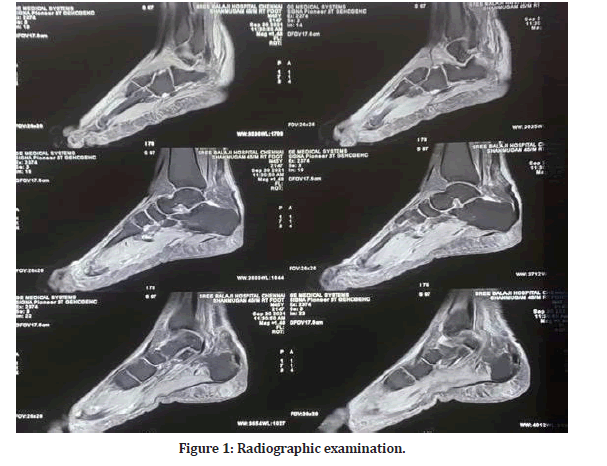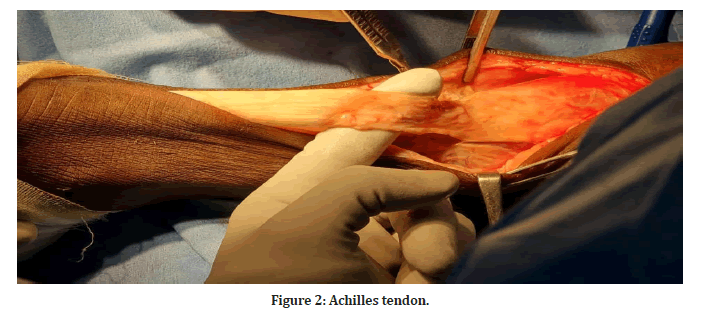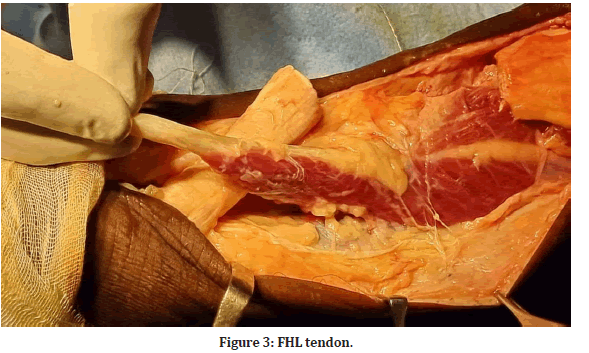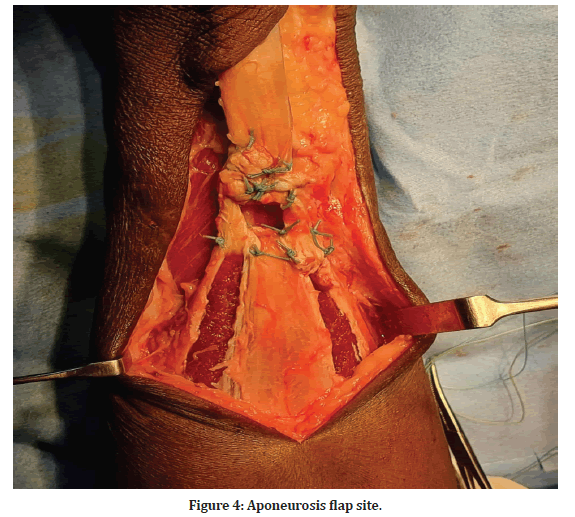Case Report - (2022) Volume 10, Issue 8
A Case Report of Flexor Hallucis Tendon Transfer in Chronically Ruptured Achilles Tendon
Vijay Narasimman Reddy* and Mervinrosario
*Correspondence: Vijay Narasimman Reddy, Department of Orthopaedics, Sree Balaji Medical College and Hospital, Works Road, New Colony, Chromepet, Chennai, Tamil Nadu, India, Email:
Abstract
To report the short-term results of flexor hallucis longus tendon transfer in chronically ruptured Achilles tendon. A chronically tendo-achilles is often difficult to treat, as there is a huge gap between the tendon ends and retraction of calf muscles. Surgical reconstruction is considered superior to conservative management. This a case report of 45-year-old male with 2 months old right Achilles tendon tear surgically corrected by flexor hallucis tendon anchored to calcaneum by a fibre wire and fixed using Lindholm technique from gastrocnemius aponeurosis. The mean follow-up period was one year, with AOFAS score of 69 pre-operatively and significantly improved to 88 post-operatively. Hence transfer of FHL for reconstruction in chronically ruptured Achilles tendons is easily performed, safe and effective in-patient with moderate demands.
Keywords
Flexor hallucis longus tendon, Ruptured Achilles tendons, Lindholm technique, AOFAS
Introduction
Achilles tendon rupture is a pre-dominantly seen in middle –aged patients. Although Achilles tendon rupture can be diagnosed through clinical examination after injury, about 10-25% of ruptures were initially undiagnosed. The management of chronic AT ruptures is quite different from acute ruptures as the ends of the tendons are retracted and atrophied. There are varies techniques used to secure the fixation of the tendon by Bone graft, screws and by fibre wire. In this case we secured the tendon by fibre wire using Lindholm technique.
Case Report
A 45 year old male patient came with history of swelling over the right foot for past 4 days, patient had history of work place injury 3months back bilateral uni-cortical fracture of tibial shaft for which below knee slab applied associated with right tibial neuropathy. Patient had clawing of 4th and 5th toe with range of motion in the ankle terminally restricted in range motion and sensation absent in 4th & 5th toe.
Radiographic examination
MRI – right foot shows Achilles tendon appears thickened and edematous for a length of -2.3cm with partial thickness tear of fibres at – 4.1cm from the calcaneal attachment; full thickness complete tear of achilles tendon with tendinous gap of -4.7mm at 13cm from the calcaneal attachment site. Proximal torn end appear thinned out (Figure 1).

Figure 1: Radiographic examination.
Since both MRI and clinical examination both suggestive of Achilles tendon tear. Patient was performed Achilles tendon reconstruction with FHL tendon transfer; patient in prone position under tourniquet control parts painted and draped, via posteromedial approach 20cm incision made from the medial border of achilles tendon, skin, subcutaneous tissue were cut & retracted, achilles tendon was identified and found to be torn and fibrosed 10cm from its calcaneal attachment fibrosed ends were cut proximally and distally, the void was measured to be 4 cm, flexor hallucis longus was identified &FHL tendon transfer was done by making a bone tunnel in the calcaneum by a fibre wire using Lindholm’s technique medial and lateral flaps were taken from gastrocnemius aponeurosis of 1cm width and 1cm length & distal end of flap was attached approximately 3cm above the cut end. The flaps were rotated to 1800 and were sutured to the distal slump. Aponeurosis flap site approximated with vicryl. Thompson’s test was done plantar flexion was present, through wound wash given, skin closed in layers and sterile dressing done (Figures 2-4).

Figure 2: Achilles tendon.

Figure 3: FHL tendon.

Figure 4: Aponeurosis flap site.
Discussion
In 25% of all acute Achilles tendon ruptures patients may undergo undiagnosed resulting in neglected or chronic states that can be difficult to treat. However the most appropriate reconstructive technique still remains controversial. Rupture is classified as chronic if the rupture is untreated for more than 4 weeks.
Gastrosoleus complex get contraction as early as 3 to 4 days. Reconstruction always becomes necessary if the treatment is delayed >4 weeks & with > 2cm in tendon defect.
The flexor hallucis longus tendon has several advantages over the flexor digitorum longus and peroneus brevis tendons [1]; it is a second strongest tendon after Gastrosoleus and offers stronger plantarflexion compared to FDL and PB tendons [2]. The axis of contraction is more in line with Achilles tendon compared to FDL and PB tendons [3]. FHL tendon lines in phase with Gastrosoleus complex [4]. FHL tendon lies anatomically proximal to Achilles tendon. Hence, the FHL tendon is preferred in calcaneal tendon reconstruction compared to others.
Great toe flexion is retained by the help of digitation present between FDL and FHL tendons after flexor hallucis longus tendon transfer. Using Lindholm technique rupture is repaired by reinforcing the sutures with living fascia that prevents adhesion of repaired tendon to the overlying skin. This technique offers simpler exposure and easy fixation to the tendon of calcaneum.
In our study patient with FHL tendon transfer show excellent result and has the mean follow-up period was one year, with AOFAS score of 69 pre-operatively and significantly improved to 88 post-operatively. Hence FHL tendon transfer is both anatomically and biomechanically well suited in achilles tendon rupture [5-12].
Conclusion
Transfer of the FHL tendon transfer using Lindholm technique from gastrocnemius aponeurosis for reconstruction of chronically ruptured Achilles tendon repair is safe, effective and easy to perform in patients with low to moderate deficits. Hence we recommend this technique in the treatment of chronic Achilles tendon rupture.
References
- O’Brien M. Functional anatomy and physiology of tendons. Clin Sports Med 1992; 11:505-520.
- Hahn F, Meyer P, Maiwald C, et al. Treatment of chronic achilles tendinopathy and ruptures with flexor hallucis tendon transfer; clinical outcome and MRI findings. Foot Ankle Int.2008; 29:794-802.
- Khan RJ, Smith RL. Surgical interventions for treating acute Achilles tendon ruptures. Cochrane Database Syst Rev 2010.
- Â Zambelli R, Pinto RZ, Magalhaes JM, et al. Development of the Brazilian Portuguese version of the achilles tendon total rupture score (ATRS BrP): A cross-cultural adaptation with reliability and construct validity evaluation. BMC Sports Sci Med Rehabil 2016; 8:11.
- Padulo J, Oliva F, Frizziero A, et al. Muscles, ligaments and tendons journalâ??basic principles and recommendations in clinical and field science research: 2016 update. MLTJ 2016; 6:1-5.
- Lui TH, Chan WC, Maffulli N. Endoscopic flexor hallucis longus tendon transfer for a failed Achilles repair: Endoscopic technique. Arthrosc Tech 2015; 4:411-416.
- Maffulli N, Oliva F, Costa V, et al. The management of chronic rupture of the Achilles tendon: minimally invasive peroneus brevis tendon transfer. Bone Joint J 2015; 97:353-357.
- Neufeld SK, Farber DC. Tendon transfers in the treatment of Achilles tendon disorders. Foot Ankle Clin 2014; 19:73-86.
- Gonçalves S, Caetano R, Corte-Real N. Salvage flexor hallucis longus transfer for a failed Achilles repair: Endoscopic technique. Arthrosc Tech 2015; 4:e411-6.
- Lin Y, Yang L, Yin L, et al. Surgical strategy for the chronic Achilles tendon rupture. BioMed Res Int 2016; 2016.
- Oksanen MM, Haapasalo HH, Elo PP, et al. Hypertrophy of the flexor hallucis longus muscle after tendon transfer in patients with chronic Achilles tendon rupture. Foot Ankle Surg 2014; 20:253-257.
- Sakaki MH, Godoy-Santos AL, Ortiz RT, et al. Flexor hallux tendon transfer: Comparative study through double or single approach. Acta Ortopédica Brasileira 2014; 22:140.
Indexed at, Google Scholar, Cross Ref
Indexed at, Google Scholar, Cross Ref
Indexed at, Google Scholar, Cross Ref
Indexed at, Google Scholar, Cross Ref
Indexed at, Google Scholar, Cross Ref
Indexed at, Google Scholar, Cross Ref
Indexed at, Google Scholar, Cross Ref
Indexed at, Google Scholar, Cross Ref
Author Info
Vijay Narasimman Reddy* and Mervinrosario
Department of Orthopaedics, Sree Balaji Medical College and Hospital, Works Road, New Colony, Chromepet, Chennai, Tamil Nadu, IndiaCitation: Vijay Narasimman Reddy, Mervinrosario, A Case Report of Flexor Hallucis Tendon Transfer in Chronically Ruptured Achilles Tendon, J Res Med Dent Sci, 2022, 10 (8): 115-118.
Received: 06-Jul-2022, Manuscript No. jrmds-22-68574; , Pre QC No. jrmds-22-68574(PQ); Editor assigned: 08-Jul-2022, Pre QC No. jrmds-22-68574(PQ); Reviewed: 23-Jul-2022, QC No. jrmds-22-68574 ; Revised: 28-Jul-2022, Manuscript No. jrmds-22-68574 (R); Published: 04-Aug-2022
